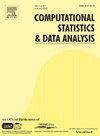基于异构均值-方差关系的潜类轨迹建模
IF 1.6
3区 数学
Q3 COMPUTER SCIENCE, INTERDISCIPLINARY APPLICATIONS
引用次数: 0
摘要
为了找到纵向轨迹的簇,研究了处理跨轨迹的异方差残差的好处。提出了通过均值-方差关系或随机残差方差来解释类别特异性异方差的模型,从而解释了轨迹特异性方差。所分析的潜级轨迹模型是生长混合模型(GMM)的扩展。通过模拟研究,评估了模型参数的估计偏差和潜在类别数量在不同数据生成模型和设置下的可恢复性。此外,通过对美国各县COVID-19病例时变发病率的分析,证明了这些模型的实证适用性。总体而言,在包含250个轨迹的数据集中,所提出的模型可以可靠地估计特定类别的平均方差。此外,考虑残差随机方差的扩展GMM比标准GMM具有更好的群体轨迹估计。本文章由计算机程序翻译,如有差异,请以英文原文为准。
Latent-class trajectory modeling with a heterogeneous mean-variance relation
The benefit of addressing heteroskedastic residual variances across trajectories is investigated with the purpose of finding clusters of longitudinal trajectories. Models are proposed to account for class-specific heteroskedasticity through a mean-variance relation or random residual variance, thereby accounting for trajectory-specific variance. The analyzed latent-class trajectory models are an extension of growth mixture models (GMM). The estimation bias of the model parameters and the recoverability of the number of latent classes are assessed under various data-generating models and settings by means of a simulation study. Furthermore, the empirical applicability of these models is demonstrated through the analysis of the time-varying incidence rate of COVID-19 cases across counties in the United States. Overall, the class-specific mean-variance could be reliably estimated by the proposed models in datasets comprising 250 trajectories. In addition, the extended GMM accounting for the residual random variance showed improved group trajectory estimation over the standard GMM.
求助全文
通过发布文献求助,成功后即可免费获取论文全文。
去求助
来源期刊

Computational Statistics & Data Analysis
数学-计算机:跨学科应用
CiteScore
3.70
自引率
5.60%
发文量
167
审稿时长
60 days
期刊介绍:
Computational Statistics and Data Analysis (CSDA), an Official Publication of the network Computational and Methodological Statistics (CMStatistics) and of the International Association for Statistical Computing (IASC), is an international journal dedicated to the dissemination of methodological research and applications in the areas of computational statistics and data analysis. The journal consists of four refereed sections which are divided into the following subject areas:
I) Computational Statistics - Manuscripts dealing with: 1) the explicit impact of computers on statistical methodology (e.g., Bayesian computing, bioinformatics,computer graphics, computer intensive inferential methods, data exploration, data mining, expert systems, heuristics, knowledge based systems, machine learning, neural networks, numerical and optimization methods, parallel computing, statistical databases, statistical systems), and 2) the development, evaluation and validation of statistical software and algorithms. Software and algorithms can be submitted with manuscripts and will be stored together with the online article.
II) Statistical Methodology for Data Analysis - Manuscripts dealing with novel and original data analytical strategies and methodologies applied in biostatistics (design and analytic methods for clinical trials, epidemiological studies, statistical genetics, or genetic/environmental interactions), chemometrics, classification, data exploration, density estimation, design of experiments, environmetrics, education, image analysis, marketing, model free data exploration, pattern recognition, psychometrics, statistical physics, image processing, robust procedures.
[...]
III) Special Applications - [...]
IV) Annals of Statistical Data Science [...]
 求助内容:
求助内容: 应助结果提醒方式:
应助结果提醒方式:


